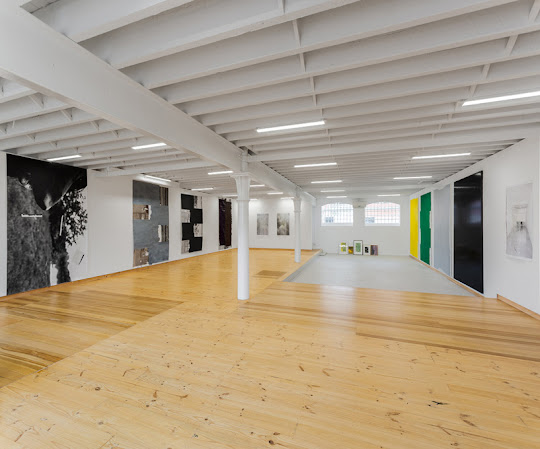DAVID THOMAS - 'Moving Times'
Blockprojects - 3rd March - 3rd April 2021
The second plus was how effective the display was for the distinctive Blockprojects architecture, with its low industrial ceiling and broad floor area, which can often intrude or squeeze the viewer’s more long range appreciation, but here, with works that stretch from floor to ceiling, precisely these circumstances are boldly confronted and converted to a measure of the work’s stature and material resources, very much a hallmark of the Minimalist approach.
Fara – a Composite of Time (2019) 250 X 180 cm - Enamel on Photo Tex on Digital Photograph (on paper)
This is to be a more polemical review than usual, but given the stagnation on offer elsewhere, a needed one. Before advancing the argument however, there are the particulars to Moving Times. David Thomas (b. 1951) is a veteran of the Melbourne scene with an extensive exhibition record here and overseas as well as a senior academic at the RMIT. Essentially a cautious, introspective man, his work did not find its mature style until a series of studio residencies in Paris in the early nineties, where exposure to French Minimalism through the BMPT group and the Supports/Surfaces movement found resonance. His work duly proceeds through stripes and symmetries, modular constructions and stricter geometry to monochromes, while frequently retaining a smaller, adjacent photographic panel, almost as a footnote. Over the years this composite identity for the work has been pursued variously as installation, collaboration, site-specific and temporary works.
Shifts in Time – Violet and Brown (2019) 250 X 183 cm acrylic on photograph
The Movement of Colour/Black (2018-9) 240 X 180 cm acrylic on digital photograph
On the facing wall, the artist’s equally large monochromes deal in integrity or consistency of a colour, depending on viewing distance and application of pigment - the ‘materiality’ in the literature (traditionally recognised as facture). Here Thomas’ touch is anxious to signal a lightness and fluency, a patience and deliberation, a kind of relaxed ‘slow painting’, albeit of a fairly modest task. Concerns with a unitary colour identity for a work - or as a work - go to the heart of Minimalism and it was the steady concession to additional properties for painting, as qualification, that eventually exhausted the project.
What has become clear by 2021, however, is that Post Modernism proved no more than an interval as the quest for intrinsic properties for painting was gradually exchanged for extrinsic properties, for social and political factors determining a work. One looks inward, for the core of form, the other looks outward, to the social network in which it arises, for content. One sees the work representing itself; the other sees the work representing the artist. Both are finally crippled by dogma, but essentially address different needs. Identity Art finds greatest application in the growing levels of art administration, in public collections and their networks, education and the profusion of art awards that now replace criticism. The concern really is with an equitable distribution of recognition for works according to favoured social profiles of artists. Yet the project is inconvenienced where the same profile results in strikingly different styles, cannot explain how a work then refers to or represents the artist, no matter how worthy the content. The project is simply blind to formal differences beyond mere illustration, can only endorse a sprawling pluralism, which in turn offers no measure for awards or recognition.
While too much form proved stultifying, too little simply grinds matters to a halt. Similarly, fear of a ‘grand narrative’ leaves art history in limbo, can only be revisited in the interests of a favoured social segment or profile. How does one recover a crucial cultural consensus? This is really part of a much broader problem, but within the sphere of art, the role of depiction or figuration cannot be confined solely to painting, the role of painting confined exclusively to figuration. The formal resources of painting need to be seen in relation to broader pictorial practices. A show like Moving Times, with its sly play upon moving (as motion or emotion) provides a surprising and timely reminder of the problem and the consequences of neglect. For an artist like Thomas it provides a vehicle of measured contemplation, somewhat like a Buddhist meditation on representation. It comes as no surprise that the artist is also an authority on traditional and contemporary Asian art, but abstraction has other uses, painting has other options. A re-engagement with the problem is overdue and underestimated.
Black Reflection Monochrome (Time/Light and Dust) 1999 244 X 183 cm acrylic on linen
ALL IMAGES COURTESY OF THE ARTIST AND BLOCKPROJECTS
My thanks to both for help in preparing this review
OTHER RESOURCES







